| Symbol | Meaning according to DIN | Meaning according to ISO |
| Fragile, Handle with care | Fragile, handle with care |
This symbol is used for fragile goods. Goods marked with this symbol should be handled carefully and should never be rolled over or tied tightly. In the case of certain hazardous goods, packages of this nature should have anything stacked on top of them. More information about this can be found in the General Provisions of the relevant regulations or in the special notes for the various classes or special goods.
| Symbol | Proprietary symbol developed by a German glass manufacturer |
 |
Meaning: Object should only be carried on edge |
This symbol can be clearly understood by anyone. When used abroad, the German "RICHTIG" and "FALSCH" can be replaced by English text, for example, "RIGHT" and "WRONG" or "DO" and "DO NOT", or colors and a clear X symbol could also be used to indicate the correct/incorrect method.
 |
|
 |
|
 |
|
| Symbol | Meaning according to DIN | Meaning according to ISO |
| Top | This way up |
The package must be stored, handled and transported in such a way that the arrows always point upwards. Rolling, swinging, severe tipping or walking of goods marked in this way must be avoided. It has been suggested that the meaning of this symbol is changed to to "transport upright" or "keep upright" in the next edition of the DIN standard.
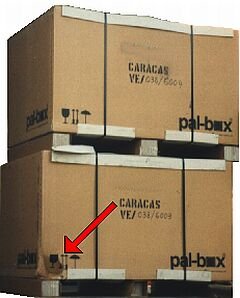 |
Pallet box and the appropriate handling symbols |
The green traffic light indicates that the package is marked correctly. However, the red traffic light and the red arrow indicate that the marking has been applied at an inappropriate location and that the package has already been damaged by incorrect handling. The strapping used is not suitably placed for handling with a forklift truck.
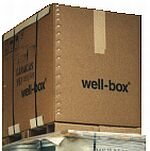 |
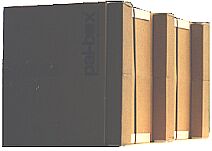 |
|
| Corrugated board carton standing and on its side | ||
If a package does not have this pair of arrows, it may be handled or transported lying on its side or even upside down, which could damage the contents.
The pair of arrows does not mean that an object must be stowed on the top layer nor do they mean "open here". The latter of these two meanings is indicated by a single arrow or other similar symbol:

A package that is marked with an arrow like the ones shown does not have to be transported upright. The correct symbol should clearly indicate the intended meaning. However applying all sorts of nonsensical symbols is a practice that should be avoided. One can only really expect long-term observance of the handling symbols if they are used sparingly and sensibly.
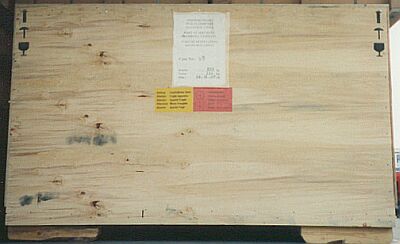 |
||
| Incorrect choice of handling symbol | ||
The shipper of this case probably wants it to be transported upright. But this is not what the symbols mean. It is also better to apply the handling symbols next to each other and on two adjacent sides.
´
| Symbol | Meaning according to DIN | Meaning according to ISO |
 |
This is not yet incorporated in the standard | Do not roll |
The package may not be rolled, swung, or tilted to any great degree during handling. The symbol should always be observed, despite the fact that it is not included in the German standard.
| Symbol | Meaning according to DIN | Meaning according to ISO |
 |
Tear off here | Tear off here |
This marking is intended only for the receiver. Generally speaking, warehouse and handling staff should not open packages.
| Symbol | Meaning according to DIN | Meaning according to ISO |
 |
No hand truck here | No hand truck here |
If this symbol is missing on one or more sides of a package it is assumed that the hand truck may be used on the unmarked sides of the package.
Although the "hand truck here" symbol does not officially exist, a symbol of this nature is often used.
 |
Meaning: Hand truck here |
The use of this symbol to provide staff with clear information is to be welcomed. Thus, for example if a carton containing a refrigerator may be moved by hand truck from two sides, but not from the other two sides, then it would make sense to use both of these symbols and apply them to the relevant sides.
| Left side of the refrigerator | Hand truck here |
| Door side of the refrigerator | No hand truck here |
| Right side of the refrigerator | Hand truck here |
| Rear of the refrigerator | No hand truck here |
| Symbol | Meaning according to DIN | Meaning according to ISO |
 |
Do not destroy barrier | Do not destroy barrier |
A barrier layer which is (virtually) impermeable to water vapor and contains desiccants for corrosion protection is located beneath the outer packaging. This protection is no longer afforded if the barrier layer is damaged. Since the corresponding symbol has not yet been approved by ISO, puncturing of the outer layer should also always be avoided for any packages bearing the words "Packed with desiccants".
For example, the handling symbol described should be applied to this package.
 |
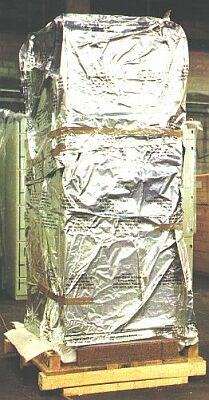 |
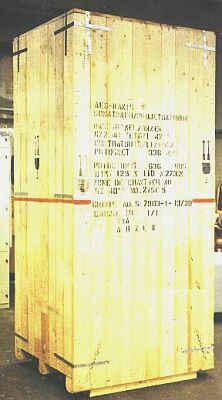 |
Above and left: Packaging for a control cabinet |
Depending how sensitive the goods are, the length of the journey, the climatic conditions, the onward carriage and standing time of the goods, the appropriate form of conservation should be employed. Goods can be protected from corrosion using coatings, spraying, painting, dipping, desiccants, volatile corrosion inhibitors (VCI method) and other effective measures. Attention should be paid to all critical issues before doing so. If in doubt, advice should be obtained from professional packers, or the job should be handed over to a reputable packing company.
Sealed packages, and in particular those in which desiccants have been included, should not contain hygroscopic materials. Packages of this nature should be carefully protected from damage.
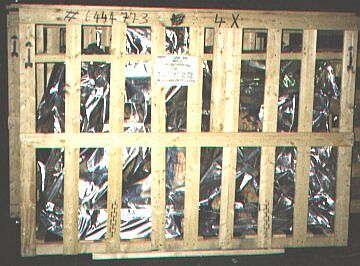 |
||
| Badly constructed and marked wooden crate | ||
The lack of diagonal bracing can lead to the crate becoming deformed and thus causing damage to the contents. The symbols indicating a sealed package are missing. This can easily be damaged during handling. A case would have been a more suitable receptacle. The single arrows do not oblige the handling staff to keep the crate upright at all times.
| Symbol | Meaning according to DIN | Meaning according to ISO |
| Electrostatic sensitive device | Electrostatic sensitive device |
Touching parts that are marked like this under relative humidity conditions of less than 70 % should be avoided if wearing electrically insulated shoes or when standing on a insulating surface. Low levels of relative humidity must in particular be expected on hot, dry summer days and very cold winter days.
| Symbol | Meaning according to DIN | Meaning according to ISO |
 |
Permitted temperature range | Temperature limitations |
According to the regulations, the symbol should either have an additional °C for a single temperature or °C max. and °C min. to give the upper and lower temperature limits of a range. The relevant temperatures or temperature limits should also be noted in the shipping documents.
Transportation of goods that are marked like this is generally carried out using refrigerated containers or vehicles, or at the very least, insulated containers or well insulated vehicles.
| Symbol | Meaning according to the hazardous goods regulations |
 |
Temperature-controlled load |
The symbol for temperature-controlled cargo has been included in the hazardous goods regulations for a number of years. The relevant hazardous goods regulations provide information about the necessary markings and their meanings.
| Symbol | Meaning according to DIN | Meaning according to ISO |
 |
Do not use forklift truck here | Do not use forklift truck here or: Use no forklift |
This symbol should only be applied to the sides of a package where a forklift truck cannot be used. Absence of the symbol on other sides of the package amounts to permission to use forklift trucks on these sides.
The following symbol is not part of either the DIN or the ISO regulations, but is sensible and should be used as required.
| Symbol | Unofficial meaning |
 |
Use forklift truck here or: Forklift here |
A sensible combination of these two symbols would be, for example, on a long case that as a result of its construction can be lifted with a forklift truck from its long sides but not from either of the ends. However, other combinations or variations are possible.
| Symbol | Meaning according to DIN | Meaning according to ISO |
 |
Stacking limitation | Stacking limitation |
The stacking limitation should be specified in kg. Since a marking of this nature is only ever applied to packages that are able to take very little load, these are usually goods that are packed in the upper layer.
If the limit is specified as 0.00 kg it should be clear to both warehouse and handling staff that the goods may not have packages stacked on top of them.
| Symbol | Recommended use with the following meaning |
 |
Only transport in the upper layer or: Top layer or: Do not stack |
The recommended use of the symbol should be clearer than any proprietary labels:
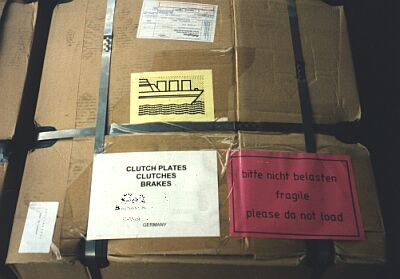 |
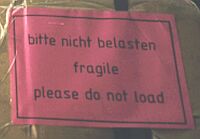 |
The phrase "Bitte nicht belasten" will be clearly understood by German-speaking staff to mean that the package should not be subjected to loads. "Fragile" on its own is no guarantee that other items will not be stowed on top of this package. The marking "Please do not load" is more likely to cause confusion, as it is not clear what is meant.
For the carriage of homogenous loads, the industry has developed a number of its own symbols which are very clearly understood and refer to the number of layers or tiers that may be formed using certain packages.
| Symbol | Meaning | |
| Only stack six layers high | ||
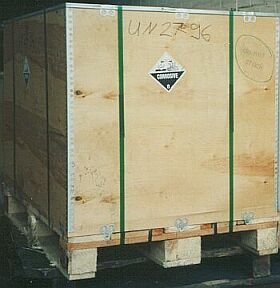 |
 |
|
| Cargo is at risk if the handling symbols are missing. | ||
If this case should not be stacked, it would be better to use the appropriate symbols instead of writing "do not stack" by hand, in German on the case. The hazardous goods regulations state that the markings on a package should be applied in such a way that they are guaranteed to survive three months exposure to sea water.
The required hazardous goods markings and their meanings can be taken from the appropriate regulations. General notes can also be found in the appropriate sections of the CTU guidelines.
| Symbol | Meaning according to DIN | Meaning according to ISO |
 |
Protect from heat and radioactive sources | Protect from heat and radioactive sources |
Since the term heat is not clearly defined here, the packages should be stowed in as cool a location as possible. In addition to this, sensitivity to the temperatures that can be expected should also be checked. The presence of radioactive sources should in theory be known as a result of adherence to the regulations or as a result of the correct labeling of packages and receptacles. If refrigerated containers or refrigerated vehicles are not to be used, it is recommended that at least insulated containers or vehicles are used. Under no circumstances should loads of this type be stacked close to the walls or roofs of normal containers or vehicles.
Certain packages such as computers and accessories, may not be exposed to magnetic fields. The industry in many countries has developed easily understood symbols to indicate this. Here is an example:
| Symbol | German meaning | English meaning |
 |
Do not expose to magnetic fields | Do not expose to magnetic fields |
Further information
When transporting items such as steel bars and pipes, for instance, the labels are very often in the form of sheet metal tags that are hung on the cargo. When handling loads of this type, it must be ensured that these tags do not become detached, as this could lead to problems with customs authorities or incorrect delivery. If a tag of this type is detached or such a detached tag is found, it must be taken to the appropriate office or person.
German terms
| Markierung von Gütern | marking of shipping goods |
| Markierung von Gütern | kind of lettering |
| Bestimmungshafen | port of destination |
| Kollo, Packstück | package |
| Bestimmunsgort | port of destination |
| Ursprungsland | country of origin |
| Gewicht | weight |
| Abmessungen | dimensions |
| Marke; Märk | mark |
| Kollianzahl | number of pieces/packages |
| Kollonummer | package number |
| markieren | to mark |
| Leitmarke | guide mark |
| Kennmarke | identification mark |
| Kennmarke | registering mark |
| Volumen | volume |